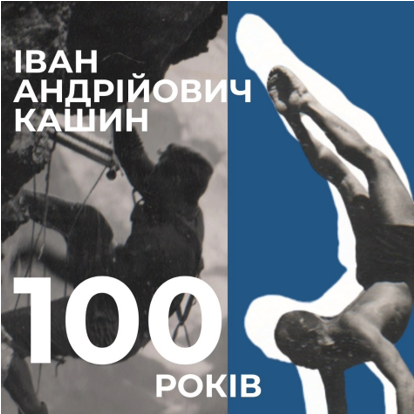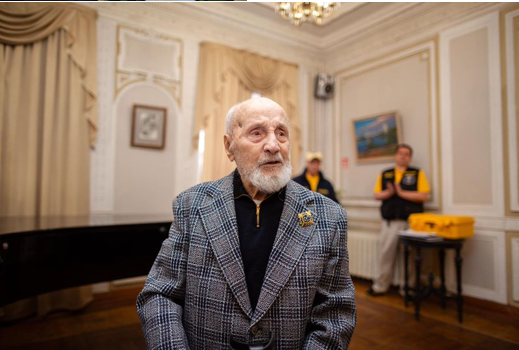Veterans do not age at heart! Kashin I.A. is 100 years old!

On 20 January 2024 (Saturday), the Kyiv House of Scientists of the National Academy of Sciences of Ukraine (45 Volodymyrska St., Kyiv) honoured the 100th anniversary of the climber Ivan Andriyovych Kashin and presented him with a certificate from the National Register of Records of Ukraine in the nomination "The Oldest Climber of Ukraine" On 18 January, the outstanding athlete, teacher, legend of Ukrainian mountaineering Ivan Andriyovych Kashin turned 100 years old.
Ivan Kashin was a Master of Sports in mountaineering, Candidate of Sports in Acrobatics, and a gymnast. Champion and prize-winner of the USSR and Ukrainian SSR mountaineering championships.
He was born on 18 January 1924 in Kyiv. He graduated from the Kyiv Institute of Physical Culture, an acrobat, gymnast and climber. He worked at Vinnytsia (1951-1952) and Kyiv (1953-1957) medical institutes at the Department of Physical Education. Since 1958, he has been a coach at the Kyiv Polytechnic Institute, and since 2009, he has been an instructor.
This is a man who can undoubtedly be called "Unbreakable". Despite the complexity of his life, Ivan Kashin always has a smile on his lips and never misses a day without exercise.
Ivan Kashin is one of the oldest climbers in our country.

Ivan Andriyovych was born in 1924 on the outskirts of Kyiv at the time of baptism. In 1932, at the age of 8, Ivan survived the Holodomor. He remembers exhausted peasants knocking on their windows and asking for at least a crumb of bread. And his mother shared the last of it with them.
In 1941, Ivan graduated from school when the Nazis invaded Ukraine. Ivan went with others to dig trenches. Later, however, Ivan and the others were forced into wagons and sent to Germany for forced labour.
After the war ended, like everyone else, he rejoiced at the victory over Nazi Germany and wanted to go home. He wanted to enter a polytechnic institute in Kyiv. But the institute refused him, arguing that he was an "enemy of the people". After several years of wandering, Ivan Kashynov entered the Kyiv Institute of Physical Culture.
While studying at the university, Ivan Kashin was a diligent student and a talented acrobat. However, he always dreamed of mountains. "Mountains are something special," says Ivan Kashin, dreamily. "When you get to the top, it's so quiet there that you're afraid to move. It feels as if the Lord himself is watching you."
In 1961, Ivan received the gold medal of the champion of the USSR despite 6 broken ribs. According to Ivan Andriyovych, the entire Ukrainian team of 6 people won the gold, and at that time he did not know that his ribs were broken. While preparing the route for the campaign, Ivan Andriyovych fell into a cone-shaped crack, but he managed to get out of there on his own. After that, there were 2 weeks left before the start of the assault on the 5 peaks. During this time, he begged off and left with the team.
Ivan Andriyovych also did not ignore Abu Ali ibn Sina Peak (Lenin Peak). He conquered it together with 38 other Ukrainians.
He survived the Second World War and the Holodomor. And he still recharges every morning.
This is what Volodymyr Dmytrovych Monogarov, head of the DSO "Avangard" team, wrote about him in his book "The Peaks of My Life":
- Vanya and I came to mountaineering. He is a strong athlete - an acrobat, calm, balanced and reliable. With a great sense of humor. Vanya peacefully resolved acute issues in the most heated disputes. I always listened to Kashin's opinion on any issue.
We offer fragments of a conversation with I. A. Kashin, recorded by Viktor Matsk.
- Ivan Andriyovych, you were at the origins of the revival of mountaineering in the Caucasus after World War II. We met and walked together with many famous, legendary climbers, about whom we have already spoken in the past. How do you remember them, what could you tell about them?
- Volodya Monogarov and Vitaly Ovcharov were the first to visit the Caucasus. I studied with them at the Kyiv Institute of Physical Culture. And in 1947, I also went to the Adil-Su Gorge, where there was a Ukrainian school of mountaineering instructors headed by Mykhailo Timofiyovych Pogrebetsky. Then the camp was called "Shakhtar", and now "Elbrus". Mykhailo Timofiyovych was much older than us, he served in the army before the revolution, he was an officer. He was known as a researcher of the "white spots" of the Tien Shan.
Before the war, he and his comrades had already climbed to the top of Khan-Tengri. M.T. Pogrebetsky was an intelligent, demanding and "normally strict" person who did not forgive the cadets' misdeeds.
This was the second year of arrangement of the territory of the "School".
Below the camp there was a bridge over the Scheldt, which was often washed away by the raging currents of the river, and we were involved in the repair work, so we joked:
"This is not a school of mountaineering, this is a school of bridge building."
The bridge had to be repaired so that the "one-and-a-half" car, which brought food to the camp, could drive over it.
I remember Vitaly Abalakov coming to our camp. He brought his experimental mountaineering equipment, was interested in our opinion and offered to test it. He was easy to communicate with us, although at that time he was already the head of the mountaineering federation.
In 1961, traversing the peaks of the Bezengi wall in the Caucasus, we found a note from his brother Yevhen on the crest of the Dykhtau peak during the tour. It was dated 1938.
After completing the traverse, Monogarov sent this note to Vitaly Abalakova in Moscow. She helped us.
Our traverse was recognized as the best of all, and for the first time we received gold medals of the champions of the USSR.
Below our camp was the "Skhelda" alpine camp, where Mykhailo Khergiani worked as an instructor. There was a rock wall near our camp, and he came here to warm up. Strong, modest, physically well built. It was interesting to watch Misha climb quickly, demonstrating high climbing technique.
- In the first years of mountaineering, climbing the peaks of Andyrchi, Via-tau and other 1 and 2 k.s. did not pose any difficulties for me. I was engaged in acrobatics, gymnastics, and it was easy for me to climb such peaks.
- And which ones did you remember?
- Those who passed in Monogarov's team.
Volodya was a good organizer: he paid a lot of attention to security issues and thought everything through to the smallest detail.
Since he was the president of the Mountaineering Federation of Ukraine, he invited the best mountaineers from all cities to his "Avangard" team. I remember them all with special warmth
Of course, I remembered the traverse of the peaks of the Bezengiy wall, because it was already high and for many days I had to walk with a heavy backpack.
- I well remember the peak of Lenin (7,134 m), which was climbed by all 38 participants. It was the first high-altitude ascent of Ukrainian climbers under the leadership of Volodymyr Monogarov. The climb was hard and exhausting, the height was obvious, but at the top I did a handstand (in those years, and this was 1962, I did acrobatics and gymnastics and could do a double somersault).
No one else has repeated such a mass ascent.
But the most technically difficult and unforgettable peak for me was Ushba.
The highest achievements in mountaineering:
1961 - Koshtan - Mizhyrgi - Dykhtau with an ascent to Koshtan by the northeastern edge of the Ullouaz glacier, 5B, first ascent - 1st place at the USSR Championship (traverse class);
1962 - Shchurovsky peak along the northern ridge - 3rd place at the USSR Championship (technical class).
Participation in the championships of the Ukrainian SSR:
1959 - Ullutau (W - W) with a climb along the northwestern "board", 5A (leader) - 2nd place at the USSR Championship (traverse class);
1960 - Shchurovsky peak in the north-western village



